Business Decision Making Report: Full Discount Ltd. UK Market
VerifiedAdded on 2020/10/04
|19
|3768
|271
Report
AI Summary
This report provides an executive summary of the business decision-making process, focusing on market research and data analysis for Full Discount Ltd.'s potential entry into the UK supermarket sector. The report outlines the research methodology, including primary data collected through questionnaires and secondary data from existing market players like B&M and Home Bargains. It analyzes consumer preferences for discounted products, factors influencing customer choices, and the competitive landscape of the UK market. The data analysis section presents findings on customer satisfaction, preferences, and the potential for new discount chains. Recommendations are provided based on the analysis of both primary and secondary data, followed by a conclusion that summarizes the key insights and implications for Full Discount Ltd. The report highlights the importance of understanding market dynamics and consumer behavior in making effective business decisions.
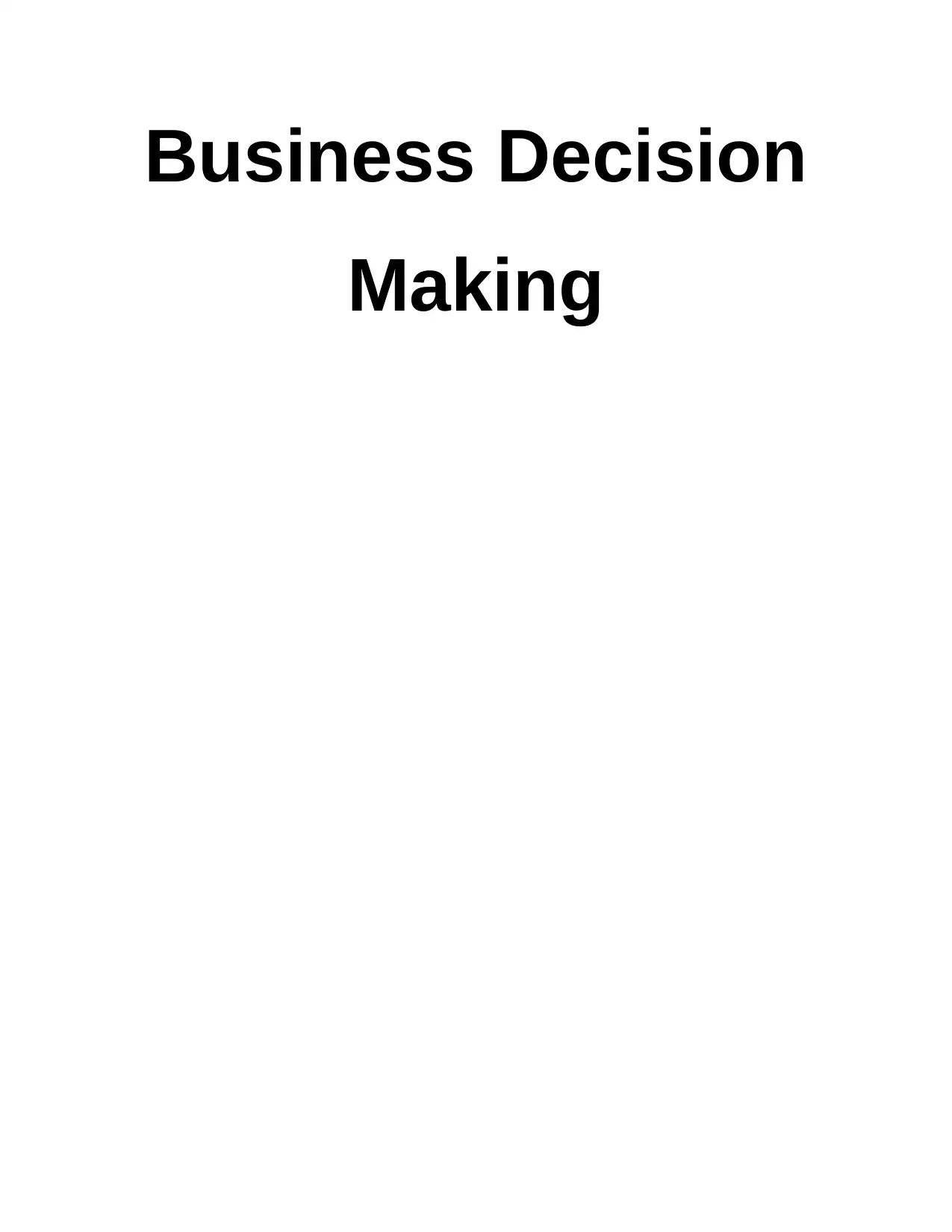
Business Decision
Making
Making
Paraphrase This Document
Need a fresh take? Get an instant paraphrase of this document with our AI Paraphraser
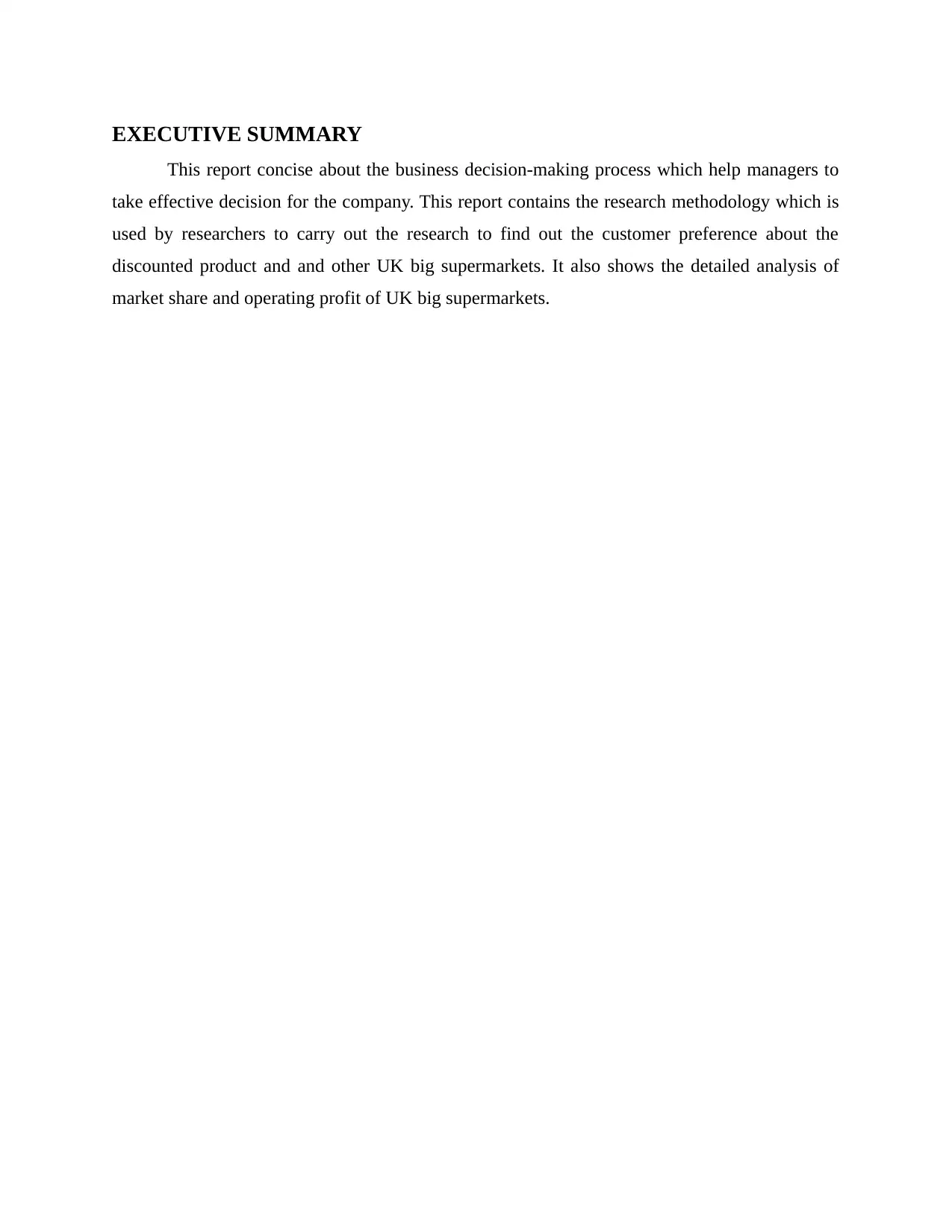
EXECUTIVE SUMMARY
This report concise about the business decision-making process which help managers to
take effective decision for the company. This report contains the research methodology which is
used by researchers to carry out the research to find out the customer preference about the
discounted product and and other UK big supermarkets. It also shows the detailed analysis of
market share and operating profit of UK big supermarkets.
This report concise about the business decision-making process which help managers to
take effective decision for the company. This report contains the research methodology which is
used by researchers to carry out the research to find out the customer preference about the
discounted product and and other UK big supermarkets. It also shows the detailed analysis of
market share and operating profit of UK big supermarkets.
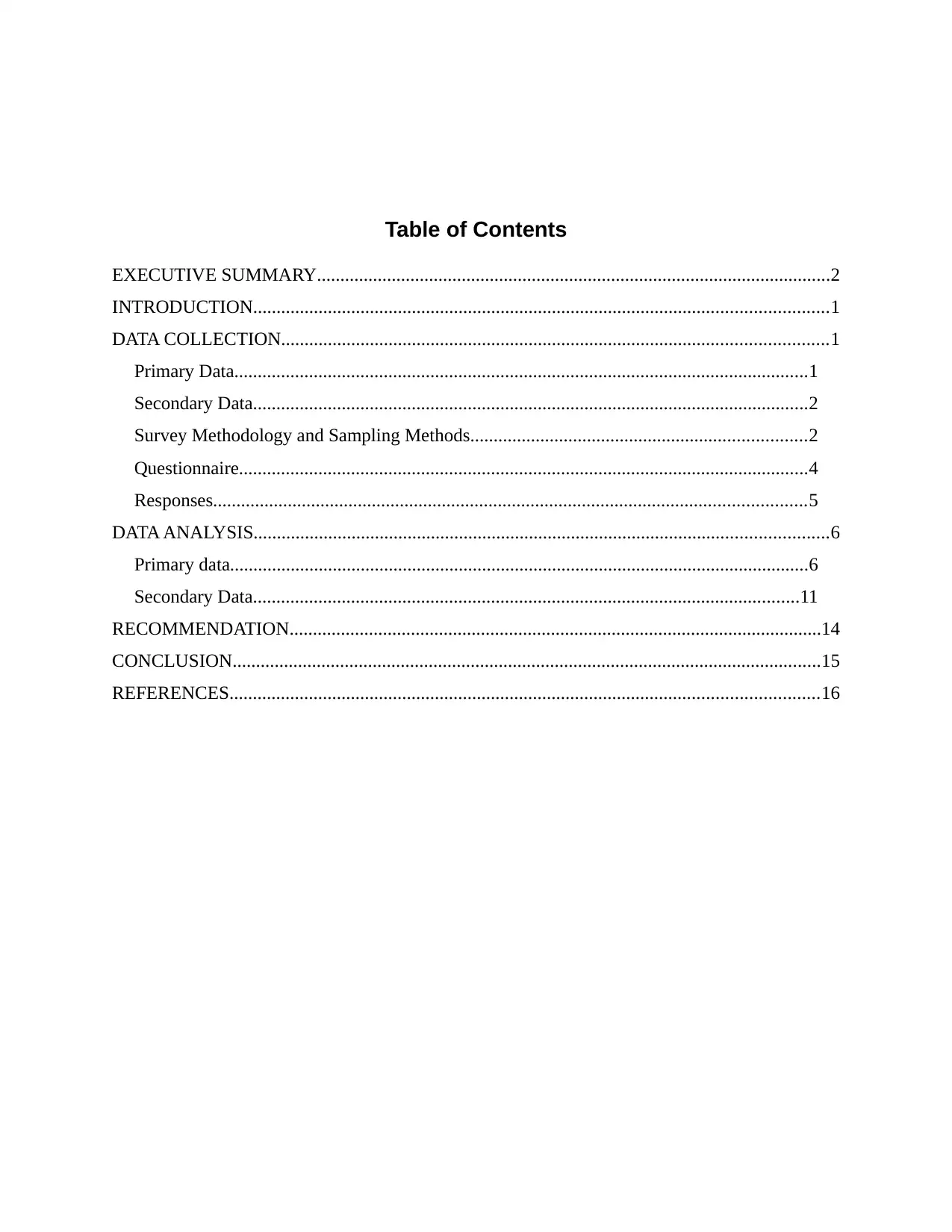
Table of Contents
EXECUTIVE SUMMARY..............................................................................................................2
INTRODUCTION...........................................................................................................................1
DATA COLLECTION.....................................................................................................................1
Primary Data...........................................................................................................................1
Secondary Data.......................................................................................................................2
Survey Methodology and Sampling Methods........................................................................2
Questionnaire..........................................................................................................................4
Responses...............................................................................................................................5
DATA ANALYSIS...........................................................................................................................6
Primary data............................................................................................................................6
Secondary Data.....................................................................................................................11
RECOMMENDATION..................................................................................................................14
CONCLUSION..............................................................................................................................15
REFERENCES..............................................................................................................................16
EXECUTIVE SUMMARY..............................................................................................................2
INTRODUCTION...........................................................................................................................1
DATA COLLECTION.....................................................................................................................1
Primary Data...........................................................................................................................1
Secondary Data.......................................................................................................................2
Survey Methodology and Sampling Methods........................................................................2
Questionnaire..........................................................................................................................4
Responses...............................................................................................................................5
DATA ANALYSIS...........................................................................................................................6
Primary data............................................................................................................................6
Secondary Data.....................................................................................................................11
RECOMMENDATION..................................................................................................................14
CONCLUSION..............................................................................................................................15
REFERENCES..............................................................................................................................16
⊘ This is a preview!⊘
Do you want full access?
Subscribe today to unlock all pages.

Trusted by 1+ million students worldwide

INTRODUCTION
Business decision making is a process which is used by companies to make a
effective decision before starting a new business or entering in a new market (Akpalu,
Alnaa and Aglobitse, 2012). Companies conduct different types of research to find out a
new trends and chances of their survival in a tough market competition. It is beneficial
for companies to conduct research before entering in a new product or starting up a
new business this help them to save its resources. With the help of these research
companies check their survival and idea of starting a new product line or new market,
these research gives a company feedback that whether they should carry out their new
project or not. The following report consists of various research methodology, types of
data collection techniques and types of data required by Full discount Ltd to open a new
store in UK market and to compete with previous established players of that particular
market i.e., B&M and Home Bargains. This report contains primary data collected from
different consumers who are availing the services of these two companies in UK market
and secondary data is obtained from various other sources, it also includes analysis of
both data secondary as well as primary.
DATA COLLECTION
Data used in a research are classified into mainly two parts i.e., Primary Data
and Secondary Data (Smyth and Lecoeuvre, 2015). These data help companies to
analyse it and prepare for the future plans of company, and also to identify problems
prevailing in society and market.
Primary Data
Primary data are the data which is collected directly by the researcher from
population or sample of study. These are directly collected from sources like individuals,
group of individuals etc. these are first hand data which is collected by a researcher
itself and is not altered. There are various techniques for collection of these data such
as Questionnaire, personal interviews, focus groups, survey etc (Bogner, 2014). data
collected from these various sources are analysed by researcher to draw a conclusion
and find out a solution of that particular problem. In the above given case scenario the
problem identified is that a company want to start a new discounted superstore in UK
1
Business decision making is a process which is used by companies to make a
effective decision before starting a new business or entering in a new market (Akpalu,
Alnaa and Aglobitse, 2012). Companies conduct different types of research to find out a
new trends and chances of their survival in a tough market competition. It is beneficial
for companies to conduct research before entering in a new product or starting up a
new business this help them to save its resources. With the help of these research
companies check their survival and idea of starting a new product line or new market,
these research gives a company feedback that whether they should carry out their new
project or not. The following report consists of various research methodology, types of
data collection techniques and types of data required by Full discount Ltd to open a new
store in UK market and to compete with previous established players of that particular
market i.e., B&M and Home Bargains. This report contains primary data collected from
different consumers who are availing the services of these two companies in UK market
and secondary data is obtained from various other sources, it also includes analysis of
both data secondary as well as primary.
DATA COLLECTION
Data used in a research are classified into mainly two parts i.e., Primary Data
and Secondary Data (Smyth and Lecoeuvre, 2015). These data help companies to
analyse it and prepare for the future plans of company, and also to identify problems
prevailing in society and market.
Primary Data
Primary data are the data which is collected directly by the researcher from
population or sample of study. These are directly collected from sources like individuals,
group of individuals etc. these are first hand data which is collected by a researcher
itself and is not altered. There are various techniques for collection of these data such
as Questionnaire, personal interviews, focus groups, survey etc (Bogner, 2014). data
collected from these various sources are analysed by researcher to draw a conclusion
and find out a solution of that particular problem. In the above given case scenario the
problem identified is that a company want to start a new discounted superstore in UK
1
Paraphrase This Document
Need a fresh take? Get an instant paraphrase of this document with our AI Paraphraser

market and is planing to offer lowest price for any product by launching a discounted
super market chain. The problem identified above is survival of company in this market
condition where two existing market players have captured whole market. Through
primary data collection company wants to know the requirements of customers and
there preference for discounted product or branded product.
Secondary Data
Secondary data is considered as a second hand data, which is already being
used by some other researchers (García-Peñalvo and Conde, 2014). These secondary
data can be collected through various sources such as new paper articles, observation,
different web sites and etc. these data are later on analysed by researcher to draw a
conclusion and provide with a solution to overcome the problem which previous
researchers failed to provide. While working with a secondary data researcher try to
provide a solution for problems which previous researchers failed to give. In the above
case company want secondary data to analyse market growth, stability and
performance of existing players which are B&M and Home Bargains. With the help of
data collected from these sources and identifying the market growth and stability of
these companies Full discount Ltd want to make plans to stabilise itself and capture
their market share.
Survey Methodology and Sampling Methods
Survey: Survey is called as a research method which is used by a researcher to
collect data from a predefined sources, these source may include a group of respondent
who want to share their own insights on a topic of interest (Hair Jr and et.al., 2015). For
collection survey various methods are used by researcher as discussed below:
Questionnaire: It is defined as a research instrument which contains a
predefined set of questions related to a problem identified by a researcher with
an aim to collect information from different respondent. Questions in any
questionnaire can be open ended, close ended or mix of both.
Interview: It a conversion between two parties interviewer and interviewee,
where a question is asked by an interviewer and interviewee gives a response
according to his knowledge in that particular area (Provost and Fawcett, 2013). It
refers to a one to one conversation between these two parties. Interview can be
2
super market chain. The problem identified above is survival of company in this market
condition where two existing market players have captured whole market. Through
primary data collection company wants to know the requirements of customers and
there preference for discounted product or branded product.
Secondary Data
Secondary data is considered as a second hand data, which is already being
used by some other researchers (García-Peñalvo and Conde, 2014). These secondary
data can be collected through various sources such as new paper articles, observation,
different web sites and etc. these data are later on analysed by researcher to draw a
conclusion and provide with a solution to overcome the problem which previous
researchers failed to provide. While working with a secondary data researcher try to
provide a solution for problems which previous researchers failed to give. In the above
case company want secondary data to analyse market growth, stability and
performance of existing players which are B&M and Home Bargains. With the help of
data collected from these sources and identifying the market growth and stability of
these companies Full discount Ltd want to make plans to stabilise itself and capture
their market share.
Survey Methodology and Sampling Methods
Survey: Survey is called as a research method which is used by a researcher to
collect data from a predefined sources, these source may include a group of respondent
who want to share their own insights on a topic of interest (Hair Jr and et.al., 2015). For
collection survey various methods are used by researcher as discussed below:
Questionnaire: It is defined as a research instrument which contains a
predefined set of questions related to a problem identified by a researcher with
an aim to collect information from different respondent. Questions in any
questionnaire can be open ended, close ended or mix of both.
Interview: It a conversion between two parties interviewer and interviewee,
where a question is asked by an interviewer and interviewee gives a response
according to his knowledge in that particular area (Provost and Fawcett, 2013). It
refers to a one to one conversation between these two parties. Interview can be
2

of many types such as online interview, telephonic interview, structured interview
and many others.
Above mentioned are two types of survey methods commonly used by researchers to
collect data in the above given scenario questionnaire methods is used for survey in
order to collect data regarding consumers preference towards discounted products or
branded products.
Sampling: Sampling is a process of choosing respondents from a total
population. It can be done through various methods depending upon the type of
research analysis which is being performed (Rutherford and et.al., 2012). The sample
which is taken should give a proper representation of the complete population.
Following are some methods of sampling:
Simple Random Sampling: In this method of sampling a respondent is selected
on a random basis, probability of getting selected is same for every respondent
present in a population. In simple random sampling process chances of getting
bias error is increased and it is subtracted from total sample.
Systematic Sampling: In this method of choosing sample a systematic sample
frame is designed and a respondent is selected on a regular interval basis. This
interval is used to ensure that an adequate sample is selected. This method is
more convenient than simple random sample.
Quota Sampling: In this type of methods sample is selected on basis of a
criteria level set by a researcher (Quanyu, Tong and Leonard, 2013). This type of
method is used by a market researcher. Main advantage with this type of
sampling method is that, respondents who are selected is directly relative to
problem for which a researcher is trying to find a solution.
Snowball Sampling: This type of sampling method is used when a research is
being conducted in social science while investigating a group population which is
hard to reach (Sutherland and et.al., 2012). In this a respondent is asked to
nominate a further respondent in order to investigate about the problem and so
on forming a snowball.
3
and many others.
Above mentioned are two types of survey methods commonly used by researchers to
collect data in the above given scenario questionnaire methods is used for survey in
order to collect data regarding consumers preference towards discounted products or
branded products.
Sampling: Sampling is a process of choosing respondents from a total
population. It can be done through various methods depending upon the type of
research analysis which is being performed (Rutherford and et.al., 2012). The sample
which is taken should give a proper representation of the complete population.
Following are some methods of sampling:
Simple Random Sampling: In this method of sampling a respondent is selected
on a random basis, probability of getting selected is same for every respondent
present in a population. In simple random sampling process chances of getting
bias error is increased and it is subtracted from total sample.
Systematic Sampling: In this method of choosing sample a systematic sample
frame is designed and a respondent is selected on a regular interval basis. This
interval is used to ensure that an adequate sample is selected. This method is
more convenient than simple random sample.
Quota Sampling: In this type of methods sample is selected on basis of a
criteria level set by a researcher (Quanyu, Tong and Leonard, 2013). This type of
method is used by a market researcher. Main advantage with this type of
sampling method is that, respondents who are selected is directly relative to
problem for which a researcher is trying to find a solution.
Snowball Sampling: This type of sampling method is used when a research is
being conducted in social science while investigating a group population which is
hard to reach (Sutherland and et.al., 2012). In this a respondent is asked to
nominate a further respondent in order to investigate about the problem and so
on forming a snowball.
3
⊘ This is a preview!⊘
Do you want full access?
Subscribe today to unlock all pages.

Trusted by 1+ million students worldwide

In the above given case for a purpose of research and to identify a trend in a market full
discount Ltd is using a simple random sampling method as company just want to know
a preference of customers liking or disliking for a product.
Questionnaire
QUESTIONNAIRE
Name:
Age:
Gender:
Contact no.
Q1) Are you satisfied from products and services of B&M ?
a) Yes
b) No
Q2) What are the different factors which attract you the most?
a) Cost
b) Location
c) Quality
d) Discounts
Q3) According to you, does Home Bargains able to provide the satisfactory
products and services?
a) Yes
b) No
Q4) What do you prefer the most ?
a) Discounted product
b) Big supermarkets
Q5) Does discounted products attract you the most?
a) Yes
b) No
Q6) On the basis of your point of view, can Tesco gain the competitive
advantages by beginning its new discount chain?
a) Yes
4
discount Ltd is using a simple random sampling method as company just want to know
a preference of customers liking or disliking for a product.
Questionnaire
QUESTIONNAIRE
Name:
Age:
Gender:
Contact no.
Q1) Are you satisfied from products and services of B&M ?
a) Yes
b) No
Q2) What are the different factors which attract you the most?
a) Cost
b) Location
c) Quality
d) Discounts
Q3) According to you, does Home Bargains able to provide the satisfactory
products and services?
a) Yes
b) No
Q4) What do you prefer the most ?
a) Discounted product
b) Big supermarkets
Q5) Does discounted products attract you the most?
a) Yes
b) No
Q6) On the basis of your point of view, can Tesco gain the competitive
advantages by beginning its new discount chain?
a) Yes
4
Paraphrase This Document
Need a fresh take? Get an instant paraphrase of this document with our AI Paraphraser
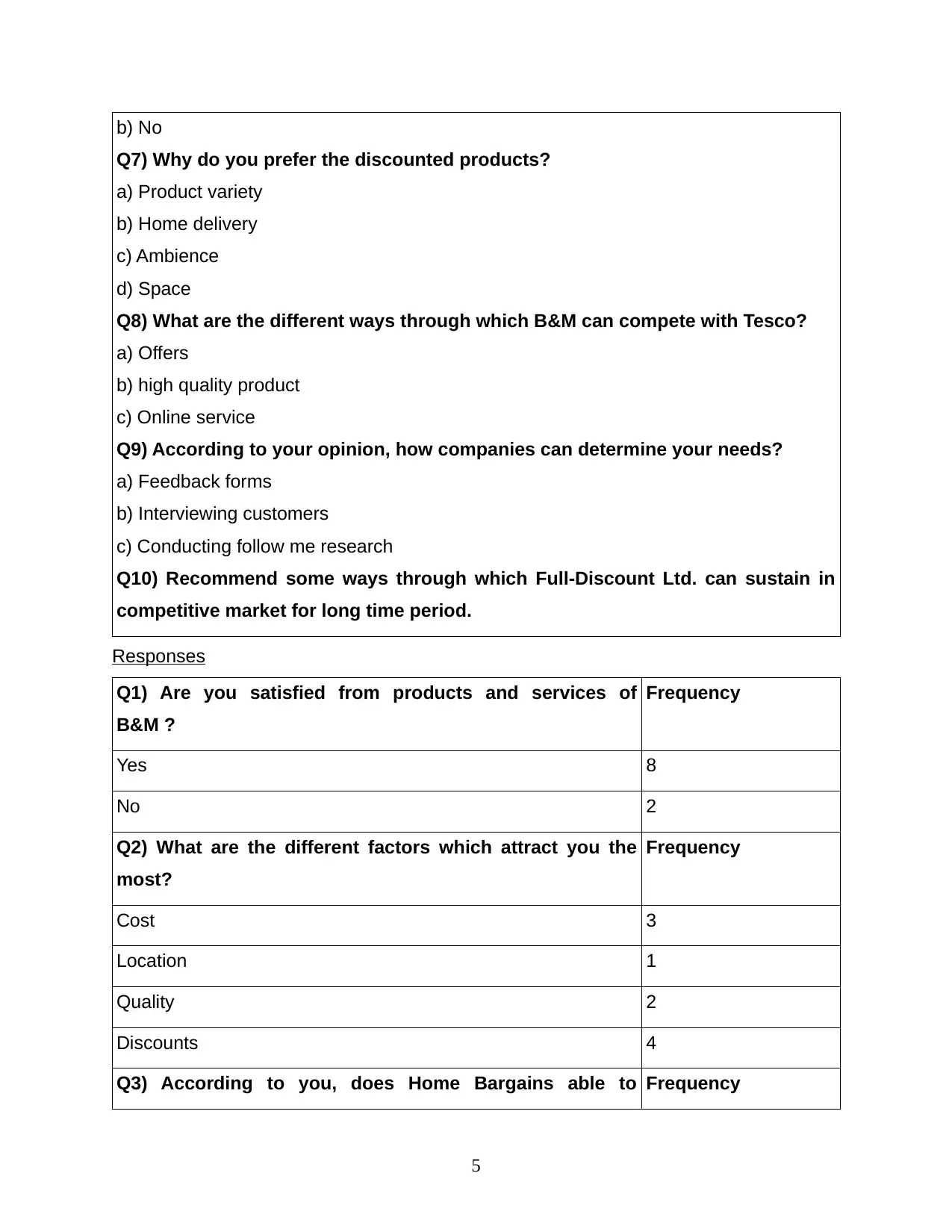
b) No
Q7) Why do you prefer the discounted products?
a) Product variety
b) Home delivery
c) Ambience
d) Space
Q8) What are the different ways through which B&M can compete with Tesco?
a) Offers
b) high quality product
c) Online service
Q9) According to your opinion, how companies can determine your needs?
a) Feedback forms
b) Interviewing customers
c) Conducting follow me research
Q10) Recommend some ways through which Full-Discount Ltd. can sustain in
competitive market for long time period.
Responses
Q1) Are you satisfied from products and services of
B&M ?
Frequency
Yes 8
No 2
Q2) What are the different factors which attract you the
most?
Frequency
Cost 3
Location 1
Quality 2
Discounts 4
Q3) According to you, does Home Bargains able to Frequency
5
Q7) Why do you prefer the discounted products?
a) Product variety
b) Home delivery
c) Ambience
d) Space
Q8) What are the different ways through which B&M can compete with Tesco?
a) Offers
b) high quality product
c) Online service
Q9) According to your opinion, how companies can determine your needs?
a) Feedback forms
b) Interviewing customers
c) Conducting follow me research
Q10) Recommend some ways through which Full-Discount Ltd. can sustain in
competitive market for long time period.
Responses
Q1) Are you satisfied from products and services of
B&M ?
Frequency
Yes 8
No 2
Q2) What are the different factors which attract you the
most?
Frequency
Cost 3
Location 1
Quality 2
Discounts 4
Q3) According to you, does Home Bargains able to Frequency
5
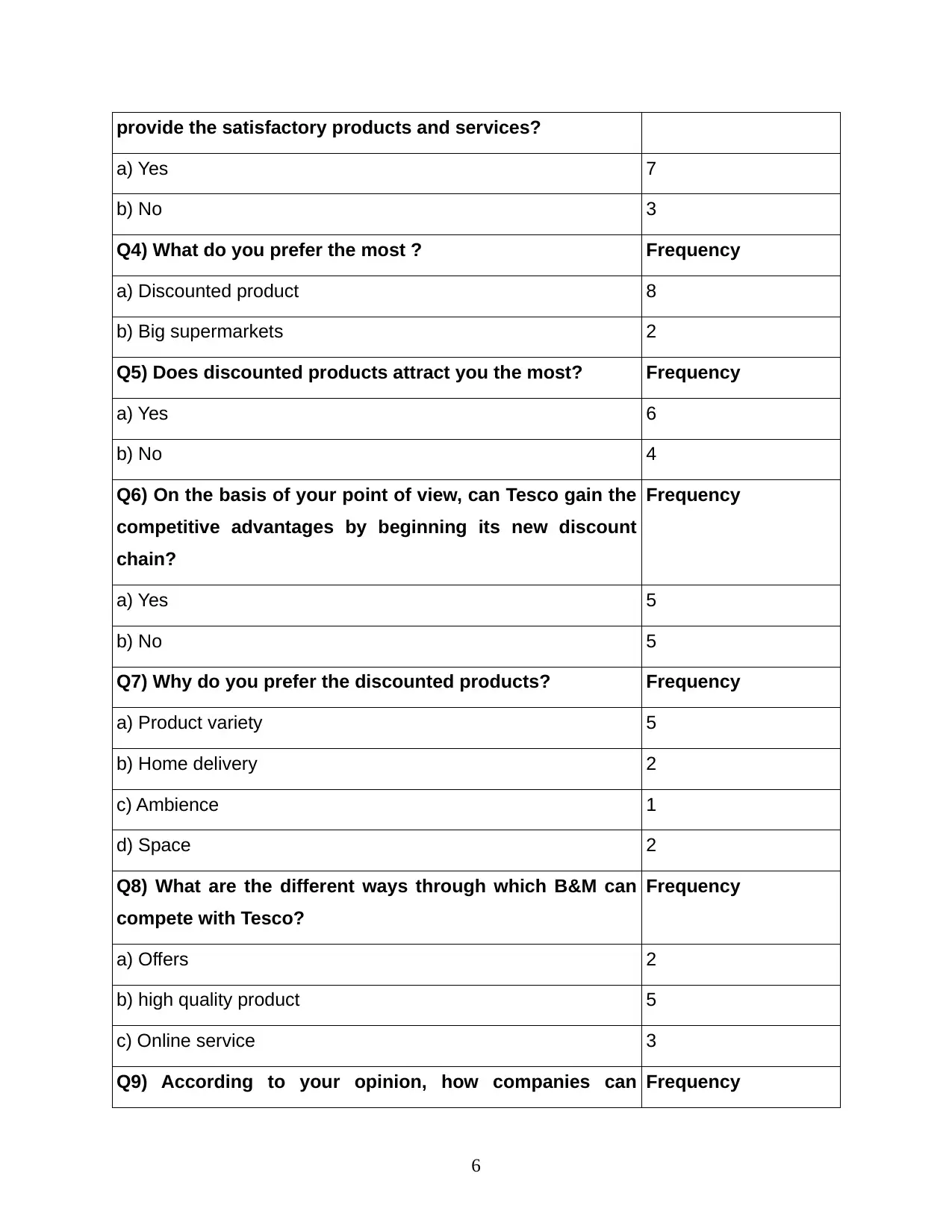
provide the satisfactory products and services?
a) Yes 7
b) No 3
Q4) What do you prefer the most ? Frequency
a) Discounted product 8
b) Big supermarkets 2
Q5) Does discounted products attract you the most? Frequency
a) Yes 6
b) No 4
Q6) On the basis of your point of view, can Tesco gain the
competitive advantages by beginning its new discount
chain?
Frequency
a) Yes 5
b) No 5
Q7) Why do you prefer the discounted products? Frequency
a) Product variety 5
b) Home delivery 2
c) Ambience 1
d) Space 2
Q8) What are the different ways through which B&M can
compete with Tesco?
Frequency
a) Offers 2
b) high quality product 5
c) Online service 3
Q9) According to your opinion, how companies can Frequency
6
a) Yes 7
b) No 3
Q4) What do you prefer the most ? Frequency
a) Discounted product 8
b) Big supermarkets 2
Q5) Does discounted products attract you the most? Frequency
a) Yes 6
b) No 4
Q6) On the basis of your point of view, can Tesco gain the
competitive advantages by beginning its new discount
chain?
Frequency
a) Yes 5
b) No 5
Q7) Why do you prefer the discounted products? Frequency
a) Product variety 5
b) Home delivery 2
c) Ambience 1
d) Space 2
Q8) What are the different ways through which B&M can
compete with Tesco?
Frequency
a) Offers 2
b) high quality product 5
c) Online service 3
Q9) According to your opinion, how companies can Frequency
6
⊘ This is a preview!⊘
Do you want full access?
Subscribe today to unlock all pages.

Trusted by 1+ million students worldwide
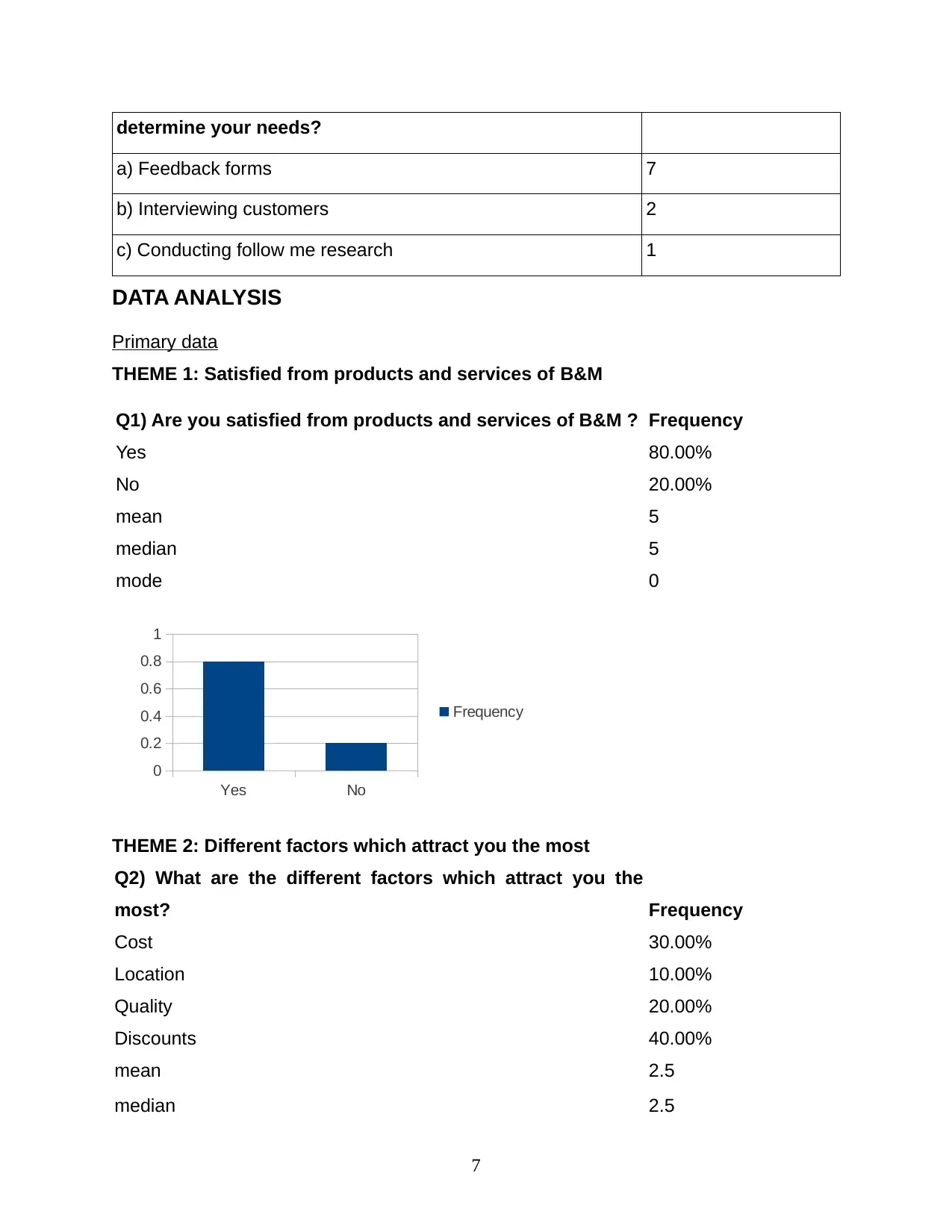
determine your needs?
a) Feedback forms 7
b) Interviewing customers 2
c) Conducting follow me research 1
DATA ANALYSIS
Primary data
THEME 1: Satisfied from products and services of B&M
Q1) Are you satisfied from products and services of B&M ? Frequency
Yes 80.00%
No 20.00%
mean 5
median 5
mode 0
Yes No
0
0.2
0.4
0.6
0.8
1
Frequency
THEME 2: Different factors which attract you the most
Q2) What are the different factors which attract you the
most? Frequency
Cost 30.00%
Location 10.00%
Quality 20.00%
Discounts 40.00%
mean 2.5
median 2.5
7
a) Feedback forms 7
b) Interviewing customers 2
c) Conducting follow me research 1
DATA ANALYSIS
Primary data
THEME 1: Satisfied from products and services of B&M
Q1) Are you satisfied from products and services of B&M ? Frequency
Yes 80.00%
No 20.00%
mean 5
median 5
mode 0
Yes No
0
0.2
0.4
0.6
0.8
1
Frequency
THEME 2: Different factors which attract you the most
Q2) What are the different factors which attract you the
most? Frequency
Cost 30.00%
Location 10.00%
Quality 20.00%
Discounts 40.00%
mean 2.5
median 2.5
7
Paraphrase This Document
Need a fresh take? Get an instant paraphrase of this document with our AI Paraphraser
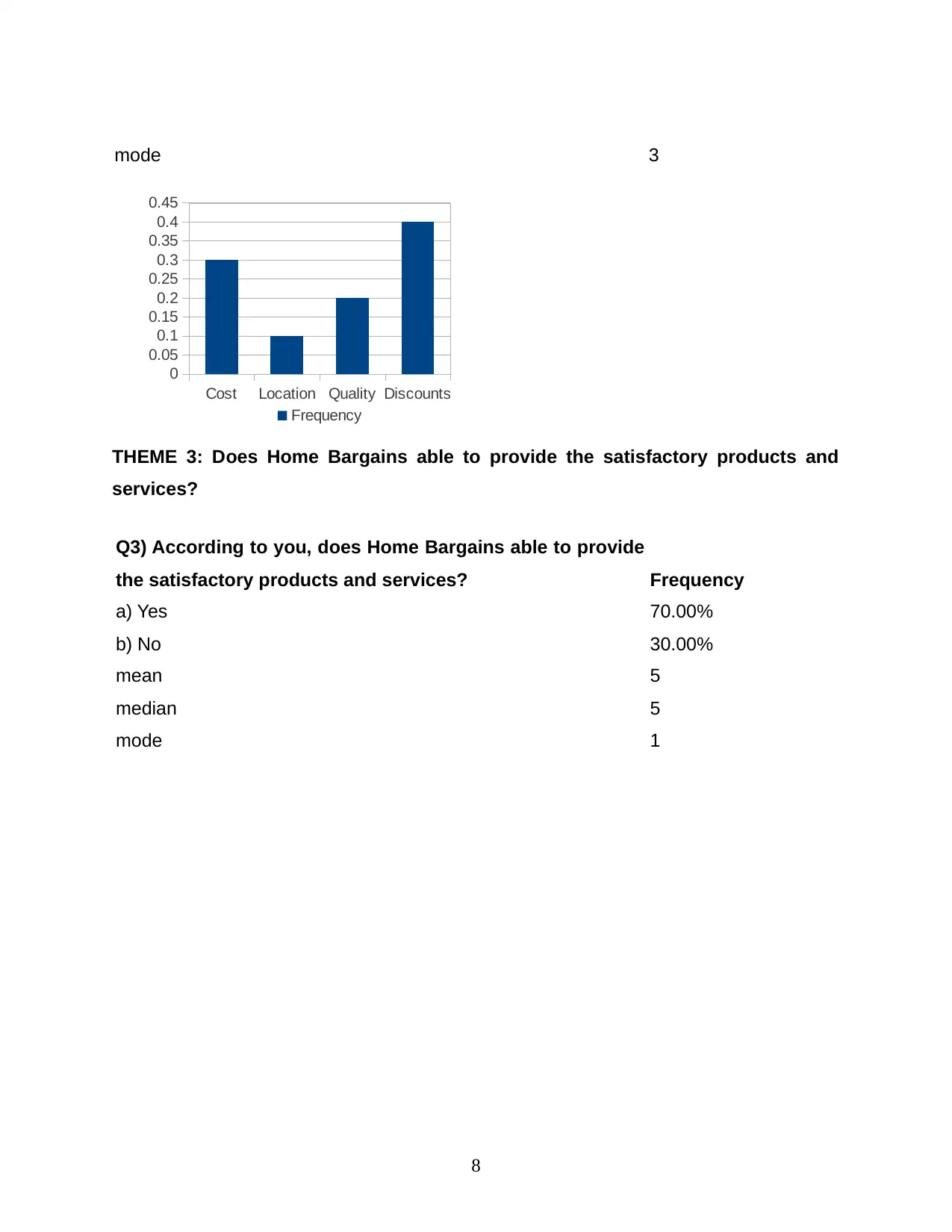
mode 3
Cost Location Quality Discounts
0
0.05
0.1
0.15
0.2
0.25
0.3
0.35
0.4
0.45
Frequency
THEME 3: Does Home Bargains able to provide the satisfactory products and
services?
Q3) According to you, does Home Bargains able to provide
the satisfactory products and services? Frequency
a) Yes 70.00%
b) No 30.00%
mean 5
median 5
mode 1
8
Cost Location Quality Discounts
0
0.05
0.1
0.15
0.2
0.25
0.3
0.35
0.4
0.45
Frequency
THEME 3: Does Home Bargains able to provide the satisfactory products and
services?
Q3) According to you, does Home Bargains able to provide
the satisfactory products and services? Frequency
a) Yes 70.00%
b) No 30.00%
mean 5
median 5
mode 1
8
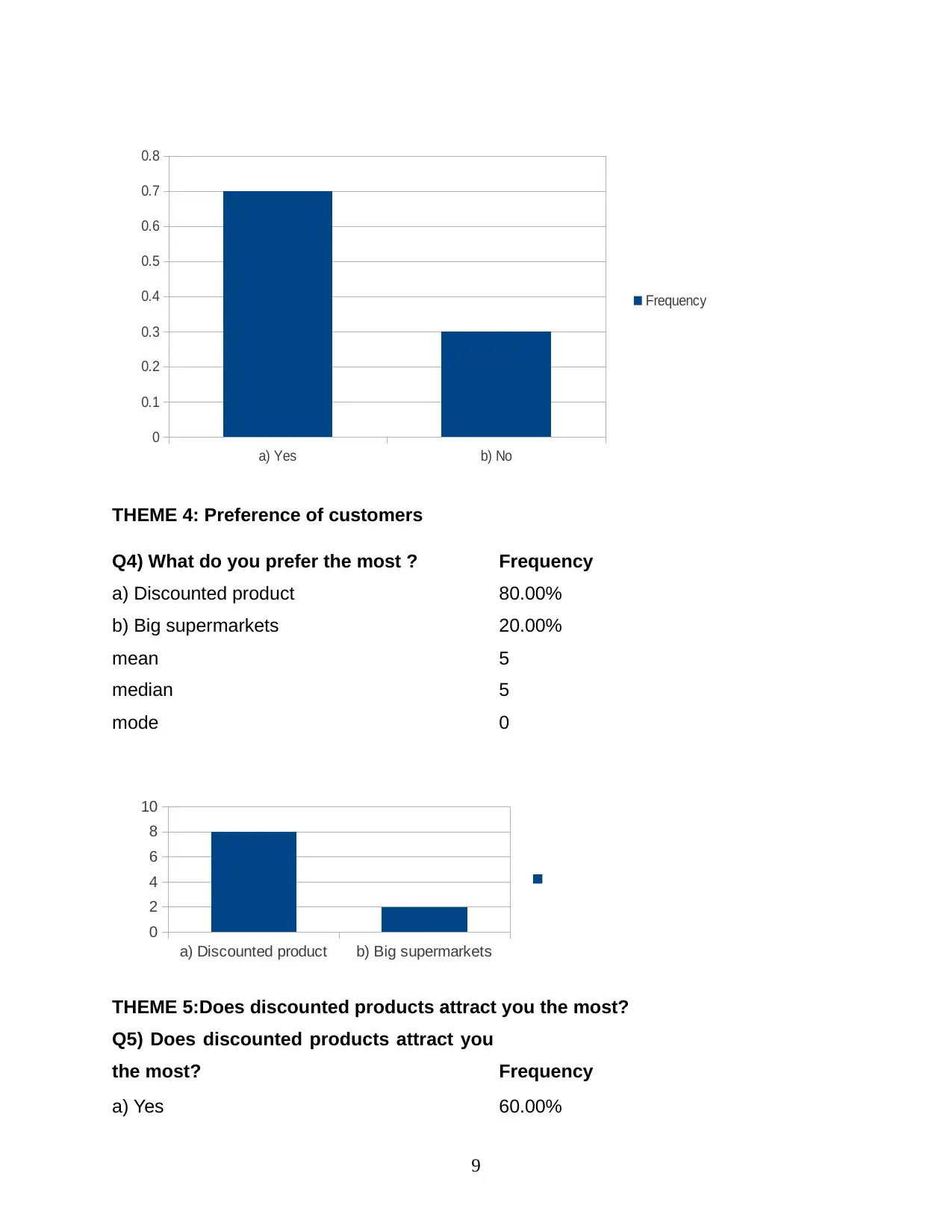
a) Yes b) No
0
0.1
0.2
0.3
0.4
0.5
0.6
0.7
0.8
Frequency
THEME 4: Preference of customers
Q4) What do you prefer the most ? Frequency
a) Discounted product 80.00%
b) Big supermarkets 20.00%
mean 5
median 5
mode 0
a) Discounted product b) Big supermarkets
0
2
4
6
8
10
THEME 5:Does discounted products attract you the most?
Q5) Does discounted products attract you
the most? Frequency
a) Yes 60.00%
9
0
0.1
0.2
0.3
0.4
0.5
0.6
0.7
0.8
Frequency
THEME 4: Preference of customers
Q4) What do you prefer the most ? Frequency
a) Discounted product 80.00%
b) Big supermarkets 20.00%
mean 5
median 5
mode 0
a) Discounted product b) Big supermarkets
0
2
4
6
8
10
THEME 5:Does discounted products attract you the most?
Q5) Does discounted products attract you
the most? Frequency
a) Yes 60.00%
9
⊘ This is a preview!⊘
Do you want full access?
Subscribe today to unlock all pages.

Trusted by 1+ million students worldwide
1 out of 19
Related Documents
Your All-in-One AI-Powered Toolkit for Academic Success.
+13062052269
info@desklib.com
Available 24*7 on WhatsApp / Email
![[object Object]](/_next/static/media/star-bottom.7253800d.svg)
Unlock your academic potential
Copyright © 2020–2025 A2Z Services. All Rights Reserved. Developed and managed by ZUCOL.





